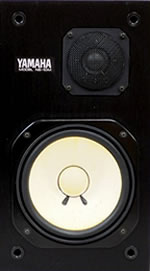
| |
| buying guide |
| ns-10mt |
| ns-10mx |
| ns-10m pro |
| ns-10m studio |
| ns-10mc |
| ns-10m |
| gallery |
| specs chart |
| naming |
| history |
| other info |
| home | contact |
| INTRO |
Of course, NS10’s can only be bought used or 2nd hand. This means that the obvious place to buy them is eBay, or your favorite alternative (Craigslist for local deals, Amazon has some too, but seems kinda expensive). Jump to buying info for:
|
These are the most common, the oldest, and the cheapest NS10's. Anything in full working condition under $400 is a bargain. Anything over $500 should be in excellent condition. BUYER BEWARE:
Check the gallery for pictures of all these differences.
BARGAINS: There are some ebay sellers who sell these directly from Japan. Even with the $200 shipping, they seem to be the best deals. And if you can negotiate on shipping, you might get them for an even better price. |
These seem to be the 2nd most common NS10’s regularly available, and their price varies greatly. They are an upgrade on the original NS-10M model, and came out 9 years after it. See the specs page and the NS-10M STUDIO page for details. BUYER BEWARE:
BARGAINS: Keep an eye out for equivalent or better models, which sometimes sell for less or the same price as the STUDIO. The NS-10MC and NS-10M PRO models are virtually the same as the NS-10M STUDIO. The MC is arguably better, in that it has the ability to be mounted. I have seen the MC sell for under $600 on eBay, which is quite a bargain, and cheaper than a lot of STUDIO models sell for. The NS-10MX is an upgrade of the STUDIO/ PRO/ MC models. As I write this, there is a set available on eBay for under $800, which again, is as much as the STUDIO models sometimes sell for, and the MX is a superior and newer model. |
These two models are almost the same as the STUDIO model, but seem to be a lot less common. The MC, like the STUDIO, sits horizontally, while the PRO stands vertical, making it similar in appearance to the original NS-10M. BUYER BEWARE:
|
This was the final NS10 made solely for studio use. It is an upgrade of the PRO/STUDIO/MC models in that the speakers are magnetically shielded. It is very rare outside of Japan. BUYER BEWARE:
BARGAINS: The NS-10MX came out six years after the PRO/STUDIO/MC models, and 15 years after the original NS-10M, meaning it has much younger components than these other models. Unfortunately, though, MX’s don’t come up for sale often. At the time of writing, there is a pair on ebay for $750 and I would be tempted to buy them myself if I didn’t already have a pair. These are amazing speakers. |
These speakers were intended for home theater and/or studio use, and came out in 1996. They are the most distinct of the NS10’s, with their bass reflex port and centered tweeter. BUYER BEWARE:
BARGAINS:The NS-10MT’s go louder and lower than any of the other NS10’s. They are ideal for budget studios who can only afford one set of speakers, or for the hobbiest who might combine their reference monitors with their home hi-fi. |
| REPLACEMENT PARTS |
TWEETERS: The original NS-10M from 1978 uses the JA0518 (JA051801) tweeter whose grill cover is quite flat. The 1987 NS-10MC, PRO and STUDIO models take the JA0518A (XC712AA0 or XC712AA1) whose grill pokes out sharply, because of the padding added to subdue the high frequencies. The JA0518’s seem to sell for between $60-100, depending on condition, while the JA0518A’s seem to go for $100-120. Both can be bought “new” (it seems Yamaha kept a lot in stock) or used. Some are made in Japan, some in Malaysia. I’m not sure if there is a difference in quality – the prices seem to be the same.
BASS DRIVER / WOOFER: The distinctive white cone woofer is a bit harder to pin down. There are two types, and as with the tweeters, each type has two names. The JA1801 (JA180100) was from the original 1978 model, but also seems to be usable in the in the 1987 PRO version at least, as this label would indicate. The JA1801A (XN542AA1) is advertised as being for the 1987 STUDIO version. I would assume that means that it is also OK for the NS-10MC too, which is virtually the same as the STUDIO. I have also read on Japanese forums, that both the JA1801 and JA1801A versions are actually interchangeable between all NS10’s. If you have any confirmable information on this matter, please contact me and I’ll post it.
BUYER BEWARE:
|
| top |
|
||
